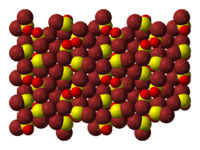Thionyl bromide
| |||
 | |||
| Names | |||
|---|---|---|---|
| IUPAC name
Thionyl bromide | |||
| Other names
Sulfur oxy dibromide | |||
| Identifiers | |||
| 507-16-4 | |||
| 3D model (Jmol) | Interactive image | ||
| ChemSpider | 61483 | ||
| ECHA InfoCard | 100.007.332 | ||
| PubChem | 68176 | ||
| |||
| |||
| Properties | |||
| SOBr2 | |||
| Molar mass | 207.87 g/mol | ||
| Appearance | colorless liquid | ||
| Density | 2.688 g/mL, liquid | ||
| Melting point | −52 °C (−62 °F; 221 K) | ||
| Boiling point | 68 °C (154 °F; 341 K) at 40 mmHg | ||
| decomposes | |||
| Solubility | reacts in HBr, acetone, and alcohol soluble in benzene, toluene, ether | ||
| Structure | |||
| trigonal pyramidal | |||
| Hazards | |||
| Main hazards | sensitive to water source of bromine, HBr | ||
| Safety data sheet | "External MSDS" | ||
| R-phrases | R14 R20/21/22 R29[1] R34 | ||
| S-phrases | (S1/2) S8[1] S26 S30 S36/37/39 S45 | ||
| Flash point | Non-flammable | ||
| Related compounds | |||
| Related compounds |
SOCl2, SeOCl2; | ||
| Except where otherwise noted, data are given for materials in their standard state (at 25 °C [77 °F], 100 kPa). | |||
| | |||
| Infobox references | |||
Thionyl bromide is the chemical compound SOBr2. It is less stable and less widely used than its chloride analogue, thionyl chloride. It is prepared by the action of hydrogen bromide on thionyl chloride, a characteristic reaction where a stronger acid is converted to a weaker acid:
- SOCl2 + 2HBr → SOBr2 + 2HCl
Thionyl bromide is used for some brominations of certain α,β-unsaturated carbonyls, and it also converts alcohols to alkyl bromides. Otherwise it hydrolyzes readily to release sulfur dioxide:
- SOBr2 + H2O → SO2 + 2HBr
Safety
SOBr2 hydrolyzes readily to release dangerous HBr and acts as a lachrymator.
References
Mundy, B. P. (2004). "Thionyl Bromide". In Paquette, E. Encyclopedia of Reagents for Organic Synthesis. New York: J. Wiley & Sons. doi:10.1002/047084289X.rt098.
| Wikimedia Commons has media related to Thionyl bromide. |
This article is issued from Wikipedia - version of the 11/14/2016. The text is available under the Creative Commons Attribution/Share Alike but additional terms may apply for the media files.

